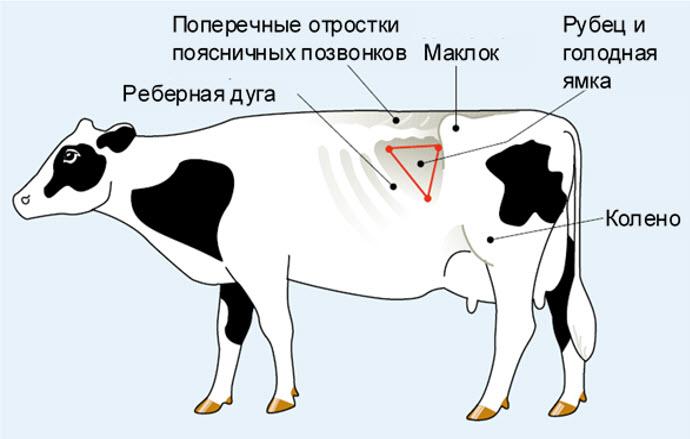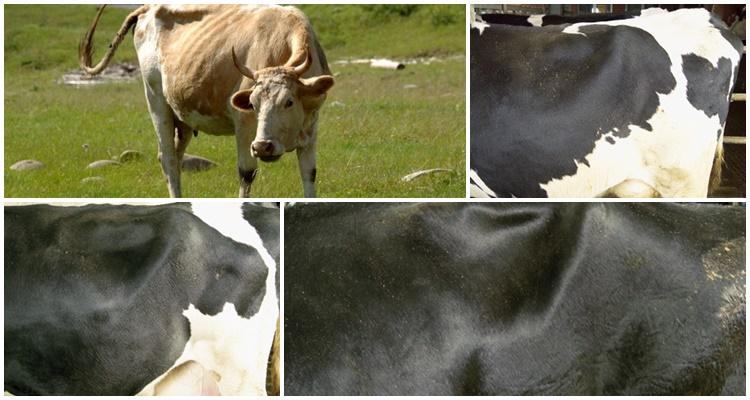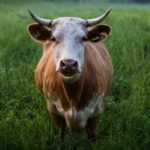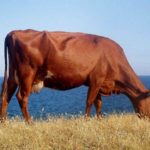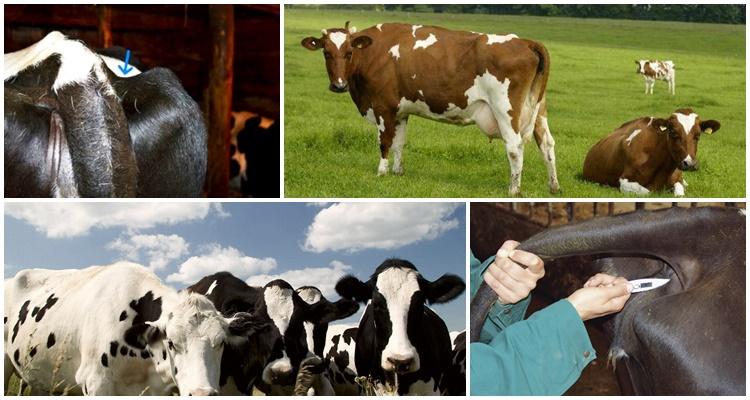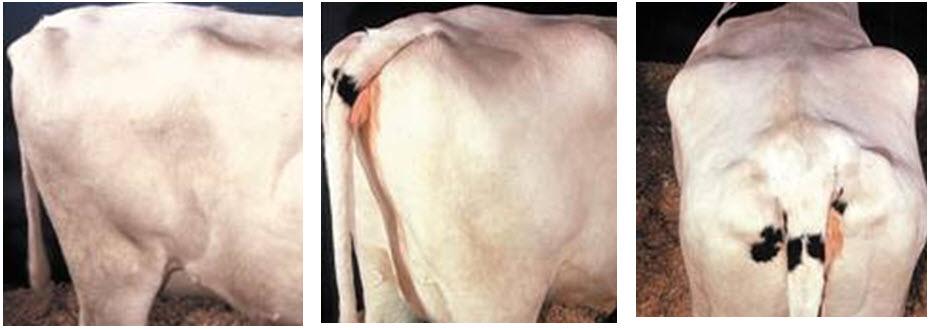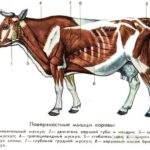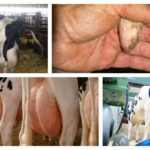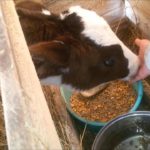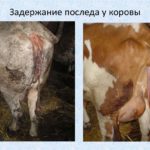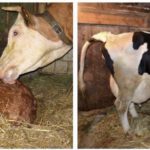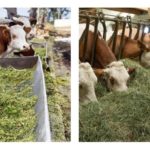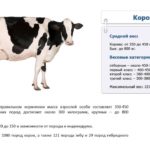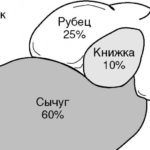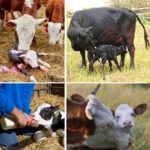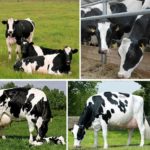To assess the effectiveness of feeding and how full the rumen of cattle is, you need to know what a hungry pit (hollow) is in a cow and where it is located. Based on its condition, you can not only determine how correctly the diet is composed and, if necessary, make timely nutritional adjustments, but also learn about the speed of metabolic processes in the body and the general state of health. How is the condition of the cavity assessed in cattle? What is the norm and what is a deviation?
What is a hungry hole?
The hunger pit in cattle is located on the body of ruminant artiodactyls and is clearly visible in the pelvic area. The depression formed by the costal arch (last rib), the transverse processes of the vertebrae and the vertebrae, is triangular in shape.
Important! Maklok is a kind of protrusion on the lower back of cattle, which forms the pelvic bone.
Hunger pit rating scale
The state of the hungry pit is assessed on a 5-point scale:
- 1 point. This indicator indicates an extremely sunken depression. The skin is very stretched, covering the transverse vertebrae. From the costal arch to the macle, the fossa is strongly concave inward, wider than the palm, which is an alarming symptom.
- 2 points. The width of the hole corresponds to the width of the palm. The depression has a clearly defined triangular or wedge-shaped shape, rounded corners. The skin fits tightly and slightly stretches the processes of the vertebrae. A fold of skin runs at an angle from the macle to the costal arch.
- 3 points. This indicator indicates the beginning of filling of the hungry fossa towards the spinal column. The depression is clearly visible behind the arch of the rib. Above the processes of the vertebrae, the skin is concave inward and closer to the vertebrae is curved outward. Triangular shaped outlines are recognized.
- 4 points. The skin located above the vertebrae falls towards the peritoneum, after which it bends outward. Behind the ribs the fold of skin is smooth and does not form a depression. Runs parallel to the maklok.
- 5 points. With this level of rumen filling, there is no transition between the stomach and the arch of the last rib. The ends of the vertebrae are not visible. The tripe is well filled. The belly is round in shape. The skin fold curves slightly outward, slightly convex in the area of the fossa.
Important! The assessment of the cavity in cattle is carried out while standing behind the animal on the left side. The examination is carried out daily, taking into account age, physiological health indicators, breed, and diet.
A low score indicates disturbances in the nutritional system, disruptions in the functioning of the digestive tract, as well as deteriorating health and systemic disorders in the cow’s body. 1-2 points indicate errors in feeding, unbalanced diets, metabolic disorders, and intestinal disorders.
One point obtained when testing the hungry hole in cattle is a sign of exhaustion, the presence of chronic, acute processes in the body of ruminants, lack of access to the food supply, the fodder trunk. This indicator indicates an imbalance in nutrition, feeding cows with low-quality, low-grade feed. Two points are acceptable for young cows at the beginning of lactation, in the first month after calving. If the depression is clearly visible with a score of two, this indicates:
- development of systemic failures in the body of cattle;
- inflammatory processes in the gastrointestinal tract;
- metabolic disorder;
- too rapid passage of food through the digestive tract;
- low digestibility of feed.
A high score indicates normal, sufficient filling of the rumen with feed. The standard criterion is 3-4 points.
Important! For dry cows, the cavity score should be at least four to five points.
Three points is the optimal parameter, which indicates the normal, sufficient condition of dairy heifers at the beginning of the lactation period or in the first two weeks after launch, which is associated with the restructuring of the body and acceleration of metabolism.
How does hunger pit assessment help in practice?
In practice, veterinarians and livestock specialists must monitor the state of the hungry hole in cattle to determine the relationship between feed consumption, condition and health of ruminant artiodactyls. Hollow testing should also be performed when cattle are transitioned to new diets, one week before the expected calving date, days 2-6, and days 8-10 after newborn calves are born.
Risk of fever
A few days before calving, as well as in the first 3-5 days from the beginning of lactation, cows experience a slight increase in general body temperature by 0.5-1.5 degrees, which is the norm.
Important! An increase in temperature by 1-2 degrees on the first day after calving does not always indicate the development of postpartum complications. But in this case, veterinarians must strictly monitor the condition of the animals.
An increase in temperature above the physiological norm is noted if, when assessing the cavity, the indicator in heifers was 1-2 points. If the hungry pit of cattle is rated one point, in such animals in the first days after lactation pathologies, diseases, systemic and functional failures of various etiopathogenesis were diagnosed.
Important! Cows with a score of two before or after calving are always at risk and require systematic monitoring.
Cows whose score was in the range of 3-5, if there were no pathologies, postpartum complications, or chronic diseases, had normal temperature readings.
Feed consumption
As for the consumption of cattle feed, when the hunger pit was assessed at 1-2 points, such animals, compared with individuals whose score was in the range of 3-5, consumed less food.The animals were diagnosed with low live weight gain, loose condition, intestinal disorders, rumen atony, other pathologies, and disturbances in the gastrointestinal tract.
To normalize the condition of ruminant animals, they were transferred to new diets taking into account age, physiological characteristics, and health status. If necessary, the diet was supplemented with probiotics and vitamin and mineral complexes. Symptomatic medications were administered to normalize metabolism, digestion, and general condition.
Calving
After the birth of calves in the studied group of cows, out of 100% in the first days after calving, 60-70% of individuals had a score of 1-2 points when testing the cavity, which was an alarming indicator. Only 30-35% of heifers after the birth of their offspring had a condition on the scale within 3-4 points.
Metabolism
If we evaluate the condition of ruminant animals, the metabolic rate by testing the cavity a week before calving and 10-12 days after the birth of babies, in the test groups, even at the 9-10th week, veterinarians noted metabolic failures and systemic disturbances in the functioning of internal organs. With minimal scores (1-3), the cattle group showed accelerated breakdown of fatty acids. This state inevitably leads to ketosis.
What to do in case of deviation from the norm?
With a sunken fossa in cattle (1-2 points), agricultural animals must be under the constant supervision of veterinarians, livestock specialists, farm workers, and livestock complexes. Necessary:
- conduct a rapid test for ketosis;
- pay attention to your diet and, if necessary, make nutritional adjustments;
- measure the amount of dry matter in the diet;
- monitor temperature and health status daily;
- prescribe medications, enzymes, vitamins to normalize metabolism and general condition.
Important! If the scar is swollen or gases accumulate, a massage is prescribed. Using rhythmic movements, press on the cavity on the left side of the cow’s body for 10-20 minutes.
It is mandatory to audit the main feed. They check the energy value of food and the quality of food consumed by animals. If necessary dry cows in the diet increase the amount of concentrated feed. Pay attention to the conditions of detention, compliance with sanitary and hygienic standards, the cleanliness of feeders and drinking bowls. Check the density of animals in barns and premises.

